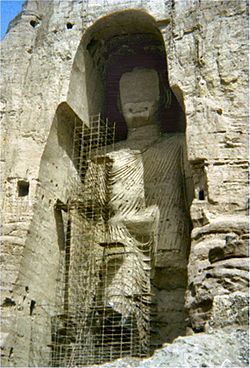Steven D. Levitt in his books Feakonomics and Super Freakonomics
asks and answers some provocative questions. For example: What school teachers
and sumo wrestlers have in common? How is a streetwalker like a department
store Santa? What do Al Gore and Mount Pinatubo have in common? He does this in
a spirit of scholarly detachment, without intent to disparage anyone. In the
spirit of Levitt’s Feakonomics I ask “How is a Federal Judge like a Taliban
warlord?”
Back before we became entangled in Afghanistan the Taliban
ran the country. Being easily offended by religious icons, the Taliban decided
to destroy some historic pieces of art—gigantic statues of Buddha carved into a
mountain overlooking the Bamyan Valley. Despite international pressure to relent and save these priceless
works of art, the Taliban dynamited the statues. [See After 1,700 years, Buddhas fall to Taliban dynamite]. I’m no Buddhist, but I was
appalled at the destruction of these monumental pieces of art.
Fast forward to the present, and we have a Federal Judge in
California who displays a Taliban attitude toward another treasured piece of
art—a gigantic cross on the top of Mount Soledad near San Diego. He has ordered that the cross be
taken down. [See Judge says giant cross must come down from San Diego mountain]. Of course, the judge himself may not have a Taliban attitude, he
may just feel that legal precedent constrains him to accede to the wishes of a
group of plaintiffs who have a Taliban attitude toward religious iconography. After
all, the government is not in the business of financing the production of
religious-themed art.
The Mount Soledad Cross*
Not so fast. If the judge had done his research, he would
have found well-established precedent for the government not only condoning,
but actually financing religious themed art. Back in the eighties the federally funded
National Endowment for the Arts actually contributed money toward the
production of “Piss Christ,” a picture of a crucifix submerged in the artist’s
urine. [See WH Silent Over Demands to Denounce ‘Piss Christ’ Artwork]. This offensive piece of “art” is
still making the rounds and no Federal Judge has seen fit to enter an order for
its destruction.
Do we as Americans have our collective heads stuck so far up
a warm, dark place that we condemn pious religious imagery while celebrating impious
religious imagery? Apparently so. The Godless old Soviet Union had a healthier
attitude toward religious iconography than we do. Remember when the Reagans visited
the Gorbachevs and the two first ladies had a dust-up over Eastern Orthodox
iconography that the USSR celebrated as great art while ignoring its religious
message? [See Nancy, Raisa in "Mexican standoff"].Perhaps we should ask another question: “Why do Russian atheists
have a more tolerant attitude toward religious iconography than American
atheists?”
The Execution of John the Baptist, an example of Russian Orthodox Iconography*
Destroying artwork of any type is boorish, and it is doubly
boorish when it is done in the name of religious intolerance. I am no Catholic,
but I was offended when I visited the Church of St. Peter and St. Paul in Bath,
England (aka Bath Abbey). Two beautiful statues, one of St. Peter and one of St. Paul flank the
doors of the main entrance to the church. At least they would be beautiful if
St. Peter had a face. Some early modern Protestant smashed St. Peter’s face. If
memory serves me (and it often doesn’t) Our guide told us that St. Peter lost his face to a Puritan iconoclast
from the time of Oliver Cromwell.
The Entrance to Bath Abbey
(If you look closely at the figure on the left, you
will see that someone has made a crude
attempt to carve a new face for St. Peter
in the wreckage of the old one)
* Courtesy of Wikimedia Commons.



No comments:
Post a Comment